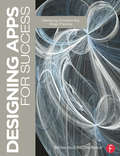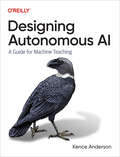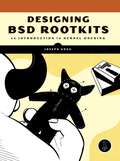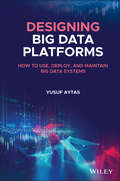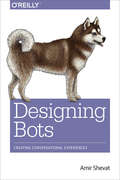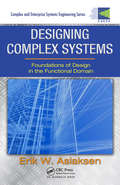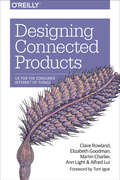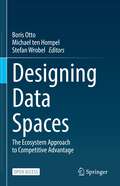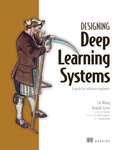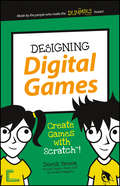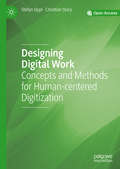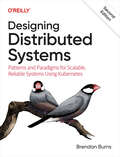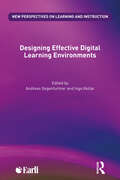- Table View
- List View
Designing Apps for Success: Developing Consistent App Design Practices
by Matthew David Chris MurmanIn 2007, Apple released the iPhone. With this release came tools as revolutionary as the internet was to businesses and individuals back in the mid- and late-nineties: Apps. Much like websites drove (and still drive) business, so too do apps drive sales, efficiencies and communication between people. But also like web design and development, in its early years and iterations, guidelines and best practices for apps are few and far between. <P><P> Designing Apps for Success provides web/app designers and developers with consistent app design practices that result in timely, appropriate, and efficiently capable apps. This book covers application lifecycle management that designers and developers use when creating apps for themselves or the entities that hired them. From the early discussions with a company as to how to what kind of app they want, to storyboarding, to developing cross platform, to troubleshooting, to publishing, Designing Apps for Success gives a taut, concise, and pragmatic roadmap from the beginning of the process all the way to the end. Developers and designers will learn not only best practices on how to design an app but how to streamline the process while not losing any quality on the end result. Other topics in this book include: <P><P> Case studies that best showcase the development process at work (or not at work). Global examples of apps developed all over the world. Future proofing your apps Post-publishing: Promoting and marketing your apps and keeping it relevant. Consistent app design practices for consistently successful results.
Designing Artificial Intelligence for Public Policy and Governance in Africa (Studies in National Governance and Emerging Technologies)
by Gedion OnyangoThis book examines the relationship between artificial intelligence and public policy in Africa. Bringing together academics and experts from multiple governance sectors, it assesses the ways in which AI is being utilised to achieve policy goals, the challenges and opportunities it presents, and how it is being governed. The book adopts a multidisciplinary approach, drawing on insights from political science, law, economics, data science, linguistics and engineering, to explore how national AI strategies are being adapted in different governance sectors across the continent. These include areas such as public safety, economic growth, electoral administration and public accountability. Attention is also given to feminist approaches to AI, and the likelihood of realising responsible AI for future public policy and governance in Africa. Practical policy recommendations are also highlighted, making this an important book for both practitioners and academics interested in African governance, public policy and AI.
Designing Autonomous AI: A Guide for Machine Teaching
by Kence AndersonEarly rules-based artificial intelligence demonstrated intriguing decision-making capabilities but lacked perception and didn't learn. AI today, primed with machine learning perception and deep reinforcement learning capabilities, can perform superhuman decision-making for specific tasks. This book shows you how to combine the practicality of early AI with deep learning capabilities and industrial control technologies to make robust decisions in the real world.Using concrete examples, minimal theory, and a proven architectural framework, author Kence Anderson demonstrates how to teach autonomous AI explicit skills and strategies. You'll learn when and how to use and combine various AI architecture design patterns, as well as how to design advanced AI without needing to manipulate neural networks or machine learning algorithms. Students, process operators, data scientists, machine learning algorithm experts, and engineers who own and manage industrial processes can use the methodology in this book to design autonomous AI.This book examines:Differences between and limitations of automated, autonomous, and human decision-makingUnique advantages of autonomous AI for real-time decision-making, with use casesHow to design an autonomous AI from modular components and document your designs
Designing BSD Rootkits: An Introduction to Kernel Hacking
by Joseph KongThough rootkits have a fairly negative image, they can be used for both good and evil. Designing BSD Rootkits arms you with the knowledge you need to write offensive rootkits, to defend against malicious ones, and to explore the FreeBSD kernel and operating system in the process.Organized as a tutorial, Designing BSD Rootkits will teach you the fundamentals of programming and developing rootkits under the FreeBSD operating system. Author Joseph Kong's goal is to make you smarter, not to teach you how to write exploits or launch attacks. You'll learn how to maintain root access long after gaining access to a computer and how to hack FreeBSD.Kongs liberal use of examples assumes no prior kernel-hacking experience but doesn't water down the information. All code is thoroughly described and analyzed, and each chapter contains at least one real-world application.Included:–The fundamentals of FreeBSD kernel module programming–Using call hooking to subvert the FreeBSD kernel–Directly manipulating the objects the kernel depends upon for its internal record-keeping–Patching kernel code resident in main memory; in other words, altering the kernel's logic while it’s still running–How to defend against the attacks describedHack the FreeBSD kernel for yourself!
Designing Big Data Platforms: How to Use, Deploy, and Maintain Big Data Systems
by Yusuf AytasDESIGNING BIG DATA PLATFORMS Provides expert guidance and valuable insights on getting the most out of Big Data systemsAn array of tools are currently available for managing and processing data—some are ready-to-go solutions that can be immediately deployed, while others require complex and time-intensive setups. With such a vast range of options, choosing the right tool to build a solution can be complicated, as can determining which tools work well with each other. Designing Big Data Platforms provides clear and authoritative guidance on the critical decisions necessary for successfully deploying, operating, and maintaining Big Data systems.This highly practical guide helps readers understand how to process large amounts of data with well-known Linux tools and database solutions, use effective techniques to collect and manage data from multiple sources, transform data into meaningful business insights, and much more. Author Yusuf Aytas, a software engineer with a vast amount of big data experience, discusses the design of the ideal Big Data platform: one that meets the needs of data analysts, data engineers, data scientists, software engineers, and a spectrum of other stakeholders across an organization. Detailed yet accessible chapters cover key topics such as stream data processing, data analytics, data science, data discovery, and data security. This real-world manual for Big Data technologies:Provides up-to-date coverage of the tools currently used in Big Data processing and managementOffers step-by-step guidance on building a data pipeline, from basic scripting to distributed systemsHighlights and explains how data is processed at scaleIncludes an introduction to the foundation of a modern data platformDesigning Big Data Platforms: How to Use, Deploy, and Maintain Big Data Systems is a must-have for all professionals working with Big Data, as well researchers and students in computer science and related fields.
Designing Bots: Creating Conversational Experiences
by Amir ShevatFrom Facebook Messenger to Kik, and from Slack bots to Google Assistant, Amazon Alexa, and email bots, the new conversational apps are revolutionizing the way we interact with software. This practical guide shows you how to design and build great conversational experiences and delightful bots that help people be more productive, whether it’s for a new consumer service or an enterprise efficiency product.Ideal for designers, product managers, and entrepreneurs, this book explores what works and what doesn’t in real-world bot examples, and provides practical design patterns for your bot-building toolbox. You’ll learn how to use an effective onboarding process, outline different flows, define a bot personality, and choose the right balance of rich control and text.Explore different bot use-cases and design best practicesUnderstand bot anatomy—such as brand and personality, conversations, advanced UI controls—and their associated design patternsLearn steps for building a Facebook Messenger consumer bot and a Slack business botExplore the lessons learned and shared experiences of designers and entrepreneurs who have built botsDesign and prototype your first bot, and experiment with user feedback
Designing Cloud Data Platforms
by Danil Zburivsky Lynda PartnerIn Designing Cloud Data Platforms, Danil Zburivsky and Lynda Partner reveal a six-layer approach that increases flexibility and reduces costs. Discover patterns for ingesting data from a variety of sources, then learn to harness pre-built services provided by cloud vendors.Summary Centralized data warehouses, the long-time defacto standard for housing data for analytics, are rapidly giving way to multi-faceted cloud data platforms. Companies that embrace modern cloud data platforms benefit from an integrated view of their business using all of their data and can take advantage of advanced analytic practices to drive predictions and as yet unimagined data services. Designing Cloud Data Platforms is a hands-on guide to envisioning and designing a modern scalable data platform that takes full advantage of the flexibility of the cloud. As you read, you&’ll learn the core components of a cloud data platform design, along with the role of key technologies like Spark and Kafka Streams. You&’ll also explore setting up processes to manage cloud-based data, keep it secure, and using advanced analytic and BI tools to analyze it. Purchase of the print book includes a free eBook in PDF, Kindle, and ePub formats from Manning Publications. About the technology Well-designed pipelines, storage systems, and APIs eliminate the complicated scaling and maintenance required with on-prem data centers. Once you learn the patterns for designing cloud data platforms, you&’ll maximize performance no matter which cloud vendor you use. About the book In Designing Cloud Data Platforms, Danil Zburivsky and Lynda Partner reveal a six-layer approach that increases flexibility and reduces costs. Discover patterns for ingesting data from a variety of sources, then learn to harness pre-built services provided by cloud vendors. What's inside Best practices for structured and unstructured data sets Cloud-ready machine learning tools Metadata and real-time analytics Defensive architecture, access, and security About the reader For data professionals familiar with the basics of cloud computing, and Hadoop or Spark. About the author Danil Zburivsky has over 10 years of experience designing and supporting large-scale data infrastructure for enterprises across the globe. Lynda Partner is the VP of Analytics-as-a-Service at Pythian, and has been on the business side of data for over 20 years. Table of Contents 1 Introducing the data platform 2 Why a data platform and not just a data warehouse 3 Getting bigger and leveraging the Big 3: Amazon, Microsoft Azure, and Google 4 Getting data into the platform 5 Organizing and processing data 6 Real-time data processing and analytics 7 Metadata layer architecture 8 Schema management 9 Data access and security 10 Fueling business value with data platforms
Designing Complex Systems: Foundations of Design in the Functional Domain (Complex and Enterprise Systems Engineering)
by Erik W. AslaksenWithout standardized construction elements such as nuts, bolts, bearings, beams, resistors and the like, the design of physical equipment is hopelessly inefficient, and engineers are continually bogged down with re-designing these elements over and over again. Emphasizing a top-down approach, this volume considers the purpose and basic features of design and how the concept of value can provide a quantitative measure of that wider interaction of the engineered object with its environment. This work also develops the domain in which functional design takes place and explores how the system concept can be embedded in that domain. It proposes a number of functional design elements and develops them in considerable detail, outlining how they can be applied as part of a coherent design framework. For greater understanding of the discussed concepts, numerous examples and analogies are included.
Designing Connected Products: UX for the Consumer Internet of Things
by Elizabeth Goodman Claire Rowland Martin Charlier Ann Light Alfred LuiNetworked thermostats, fitness monitors, and door locks show that the Internet of Things can (and will) enable new ways for people to interact with the world around them. But designing connected products for consumers brings new challenges beyond conventional software UI and interaction design.This book provides experienced UX designers and technologists with a clear and practical roadmap for approaching consumer product strategy and design in this novel market. By drawing on the best of current design practice and academic research, Designing Connected Products delivers sound advice for working with cross-device interactions and the complex ecosystems inherent in IoT technology.
Designing Constructionist Futures: The Art, Theory, and Practice of Learning Designs
by Nathan Holbert, Matthew Berland, and Yasmin B. KafaiA diverse group of scholars redefine constructionism--introduced by Seymour Papert in 1980--in light of new technologies and theories.Constructionism, first introduced by Seymour Papert in 1980, is a framework for learning to understand something by making an artifact for and with other people. A core goal of constructionists is to respect learners as creators, to enable them to engage in making meaning for themselves through construction, and to do this by democratizing access to the world's most creative and powerful tools. In this volume, an international and diverse group of scholars examine, reconstruct, and evolve the constructionist paradigm in light of new technologies and theories.
Designing Courses with Digital Technologies: Insights and Examples from Higher Education
by Stefan HrastinskiDesigning Courses with Digital Technologies offers guidance for higher education instructors integrating digital technologies into their teaching, assessment and overall support of students. Written by and for instructors from a variety of disciplines, this book presents evaluations that the contributors have implemented in real-life courses, spanning blended and distance learning, flipped classrooms, collaborative technologies, video-supported learning and beyond. Chapter authors contextualize their approaches beyond simple how-tos, exploring both the research foundations and professional experiences that have informed their use of digital tools while reflecting on their successes, challenges and ideas for future development.
Designing Data Spaces: The Ecosystem Approach to Competitive Advantage
by Michael Ten Hompel Boris Otto Stefan WrobelThis open access book provides a comprehensive view on data ecosystems and platform economics from methodical and technological foundations up to reports from practical implementations and applications in various industries. To this end, the book is structured in four parts: Part I “Foundations and Contexts” provides a general overview about building, running, and governing data spaces and an introduction to the IDS and GAIA-X projects. Part II “Data Space Technologies” subsequently details various implementation aspects of IDS and GAIA-X, including eg data usage control, the usage of blockchain technologies, or semantic data integration and interoperability. Next, Part III describes various “Use Cases and Data Ecosystems” from various application areas such as agriculture, healthcare, industry, energy, and mobility. Part IV eventually offers an overview of several “Solutions and Applications”, eg including products and experiences from companies like Google, SAP, Huawei, T-Systems, Innopay and many more. Overall, the book provides professionals in industry with an encompassing overview of the technological and economic aspects of data spaces, based on the International Data Spaces and Gaia-X initiatives. It presents implementations and business cases and gives an outlook to future developments. In doing so, it aims at proliferating the vision of a social data market economy based on data spaces which embrace trust and data sovereignty.
Designing Data Visualizations: Representing Informational Relationships
by Noah Iliinsky Julie SteeleData visualization is an efficient and effective medium for communicating large amounts of information, but the design process can often seem like an unexplainable creative endeavor. This concise book aims to demystify the design process by showing you how to use a linear decision-making process to encode your information visually.Delve into different kinds of visualization, including infographics and visual art, and explore the influences at work in each one. Then learn how to apply these concepts to your design process.Learn data visualization classifications, including explanatory, exploratory, and hybridDiscover how three fundamental influences—the designer, the reader, and the data—shape what you createLearn how to describe the specific goal of your visualization and identify the supporting dataDecide the spatial position of your visual entities with axesEncode the various dimensions of your data with appropriate visual properties, such as shape and colorSee visualization best practices and suggestions for encoding various specific data types
Designing Data-Intensive Applications: The Big Ideas Behind Reliable, Scalable, and Maintainable Systems
by Martin KleppmannData is at the center of many challenges in system design today. Difficult issues need to be figured out, such as scalability, consistency, reliability, efficiency, and maintainability. In addition, we have an overwhelming variety of tools, including relational databases, NoSQL datastores, stream or batch processors, and message brokers. What are the right choices for your application? How do you make sense of all these buzzwords?In this practical and comprehensive guide, author Martin Kleppmann helps you navigate this diverse landscape by examining the pros and cons of various technologies for processing and storing data. Software keeps changing, but the fundamental principles remain the same. With this book, software engineers and architects will learn how to apply those ideas in practice, and how to make full use of data in modern applications.Peer under the hood of the systems you already use, and learn how to use and operate them more effectivelyMake informed decisions by identifying the strengths and weaknesses of different toolsNavigate the trade-offs around consistency, scalability, fault tolerance, and complexityUnderstand the distributed systems research upon which modern databases are builtPeek behind the scenes of major online services, and learn from their architectures
Designing Deep Learning Systems: A software engineer's guide
by Chi Wang Donald SzetoA vital guide to building the platforms and systems that bring deep learning models to production.In Designing Deep Learning Systems you will learn how to: Transfer your software development skills to deep learning systems Recognize and solve common engineering challenges for deep learning systems Understand the deep learning development cycle Automate training for models in TensorFlow and PyTorch Optimize dataset management, training, model serving and hyperparameter tuning Pick the right open-source project for your platform Deep learning systems are the components and infrastructure essential to supporting a deep learning model in a production environment. Written especially for software engineers with minimal knowledge of deep learning&’s design requirements, Designing Deep Learning Systems is full of hands-on examples that will help you transfer your software development skills to creating these deep learning platforms. You&’ll learn how to build automated and scalable services for core tasks like dataset management, model training/serving, and hyperparameter tuning. This book is the perfect way to step into an exciting—and lucrative—career as a deep learning engineer. About the technology To be practically usable, a deep learning model must be built into a software platform. As a software engineer, you need a deep understanding of deep learning to create such a system. Th is book gives you that depth. About the book Designing Deep Learning Systems: A software engineer's guide teaches you everything you need to design and implement a production-ready deep learning platform. First, it presents the big picture of a deep learning system from the developer&’s perspective, including its major components and how they are connected. Then, it carefully guides you through the engineering methods you&’ll need to build your own maintainable, efficient, and scalable deep learning platforms. What's inside The deep learning development cycle Automate training in TensorFlow and PyTorch Dataset management, model serving, and hyperparameter tuning A hands-on deep learning lab About the reader For software developers and engineering-minded data scientists. Examples in Java and Python. About the author Chi Wang is a principal software developer in the Salesforce Einstein group. Donald Szeto was the co-founder and CTO of PredictionIO. Table of Contents 1 An introduction to deep learning systems 2 Dataset management service 3 Model training service 4 Distributed training 5 Hyperparameter optimization service 6 Model serving design 7 Model serving in practice 8 Metadata and artifact store 9 Workflow orchestration 10 Path to production
Designing Delivery: Rethinking IT in the Digital Service Economy
by Jeff SussnaNow that we’re moving from a product economy to a digital service economy, software is becoming critical for navigating our everyday lives. The quality of your service depends on how well it helps customers accomplish goals and satisfy needs. Service quality is not about designing capabilities, but about making—and keeping—promises to customers.To help you improve customer satisfaction and create positive brand experiences, this pragmatic book introduces a transdisciplinary approach to digital service delivery. Designing a resilient service today requires a unified effort across front-office and back-office functions and technical and business perspectives. You’ll learn how make IT a full partner in the ongoing conversations you have with your customers.Take a unique customer-centered approach to the entire service delivery lifecycleApply this perspective across development, operations, QA, design, project management, and marketingImplement a specific quality assurance methodology that unifies those disciplinesUse the methodology to achieve true resilience, not just stability
Designing Digital Games
by Derek BreenThe easy way for kids to get started with video game design Is your youngster a designer at heart? Read on! Designing Digital Games helps children apply their design skills to video game design using Scratch--and this book! Introducing simple programming concepts over the course of three easy-to-follow projects, it shows your child how to use the free Scratch platform to create a video game from the ground up. An extension of the trusted For Dummies brand, this juvenile book has a focus on accomplishment and provides all the steps to help young readers learn basic programming concepts to complete cool projects. From using sprites to create a game with a digital pet snake to creating maze games and cloning sprites to create a fun, attack-style game, this approachable guide offers simple, friendly instruction while building kids' confidence in designing digital games. Features a design that is heavy on eye-popping graphics your child will love Content is focused on the steps to completing each of the projects Offers a small, full-color, non-intimidating package that instills confidence in readers Includes basic projects that set the young learner on the road to further exploration of video game design If there's a kid aged 7-11 in your life who has an interest in using Scratch to design digital games, this book provides the building blocks they need to take their hobby to the next level.
Designing Digital Musical Instruments Using Probatio: A Physical Prototyping Toolkit (Computational Synthesis and Creative Systems)
by Filipe CalegarioThe author presents Probatio, a toolkit for building functional DMI (digital musical instruments) prototypes, artifacts in which gestural control and sound production are physically decoupled but digitally mapped. He uses the concept of instrumental inheritance, the application of gestural and/or structural components of existing instruments to generate ideas for new instruments. To support analysis and combination, he then leverages a traditional design method, the morphological chart, in which existing artifacts are split into parts, presented in a visual form and then recombined to produce new ideas. And finally he integrates the concept and the method in a concrete object, a physical prototyping toolkit for building functional DMI prototypes: Probatio. The author's evaluation of this modular system shows it reduces the time required to develop functional prototypes. The book is useful for researchers, practitioners, and graduate students in the areas of musical creativity and human-computer interaction, in particular those engaged in generating, communicating, and testing ideas in complex design spaces.
Designing Digital Products for Kids: Deliver User Experiences That Delight Kids, Parents, and Teachers
by Rubens CantuniChildhood learning is now more screen-based than ever before, and app developers are flocking in droves to this lucrative and exciting market. The younger generation deserves the best, and growing up in a digital world has made them discerning and demanding customers. Creating a valuable user experience for a child is as complex and involved as when designing a typical app for an adult, if not more, and Designing Digital Products for Kids is here to be your guide. Author and designer Rubens Cantuni recognizes the societal importance of a high-quality and ethical app experience for children. There is room for significant improvement in this space, and Cantuni helps you optimize it. Designing Digital Products for Kids walks hopeful developers through digital product design—including research, concept, design, release, marketing, testing, analyzing, and iterating—all while aiming to build specifically for children. Industry experts and their real-world advice are showcased in this book, along with careful advice for the ethics that go along with this unique market. These tips include complex needs regarding mental development, accessibility, conscious screen time limits, and content sensitivity. Children, parents, and teachers alike are hungry for more thoughtful players in the kids’ app space, and Designing Digital Products for Kids is your ticket to successfully developing and educating for the future. What You Will LearnDesign platforms specifically for children, to entertain and educate themWork with a complex audience of parents, teachers and kidsUnderstand how different monetization strategies work in this industry and why Who This Book Is ForUser experience designers, UI designers, product owners, teachers and educators, startup founders. The range of topics is so wide that anyone interested or involved in digital products could find something interesting to learn.
Designing Digital Work: Concepts and Methods for Human-centered Digitization
by Christian Stary Stefan OpplCombining theory, methodology and tools, this open access book illustrates how to guide innovation in today’s digitized business environment. Highlighting the importance of human knowledge and experience in implementing business processes, the authors take a conceptual perspective to explore the challenges and issues currently facing organizations. Subsequent chapters put these concepts into practice, discussing instruments that can be used to support the articulation and alignment of knowledge within work processes. A timely and comprehensive set of tools and case studies, this book is essential reading for those researching innovation and digitization, organization and business strategy.
Designing Displays for Older Adults, Second Edition
by Anne McLaughlin Richard PakThis book focuses on the design of displays and user interfaces for the older user. Aging is related to complex mental, physical, and social changes. While conventional wisdom says getting older leads to a decline, the reality is that some capabilities decline with age while others remain stable or increase. This book distills decades of aging research into practical advice on the design of displays. Technology has changed dramatically since the publication of the first edition. This new edition covers cutting-edge technology design such as ubiquitous touchscreens, smart speakers, and augmented reality interfaces, among others.
Designing Distributed Systems: Patterns and Paradigms for Scalable, Reliable Services
by Brendan BurnsIn the race to compete in today’s fast-moving markets, large enterprises are busy adopting new technologies for creating new products, processes, and business models. But one obstacle on the road to digital transformation is placing too much emphasis on technology, and not enough on the types of processes technology enables. What if different lines of business could build their own services and applications—and decision-making was distributed rather than centralized?This report explores the concept of a digital business platform as a way of empowering individual business sectors to act on data in real time. Much innovation in a digital enterprise will increasingly happen at the edge, whether it involves business users (from marketers to data scientists) or IoT devices. To facilitate the process, your core IT team can provide these sectors with the digital tools they need to innovate quickly.This report explores:Key cultural and organizational changes for developing business capabilities through cross-functional product teamsA platform for integrating applications, data sources, business partners, clients, mobile apps, social networks, and IoT devicesCreating internal API programs for building innovative edge services in low-code or no-code environmentsTools including Integration Platform as a Service, Application Platform as a Service, and Integration Software as a ServiceThe challenge of integrating microservices and serverless architecturesEvent-driven architectures for processing and reacting to events in real timeYou’ll also learn about a complete pervasive integration solution as a core component of a digital business platform to serve every audience in your organization.
Designing Distributed Systems: Patterns and Paradigms for Scalable, Reliable Systems Using Kubernetes
by Brendan BurnsEvery distributed system strives for reliability, performance, and quality, but building such a system is hard. Establishing a set of design patterns enables software developers and system architects to use a common language to describe their systems and learn from the patterns and practices developed by others.The popularity of containers and Kubernetes paves the way for core distributed system patterns and reusable containerized components. This practical guide presents a collection of repeatable, generic patterns to help guide the systems you build using common patterns and practices drawn from some of the highest performing distributed systems in use today. These common patterns make the systems you build far more approachable and efficient, even if you've never built a distributed system before.Author Brendan Burns demonstrates how you can adapt existing software design patterns for designing and building reliable distributed applications. Systems engineers and application developers will learn how these long-established patterns provide a common language and framework for dramatically increasing the quality of your system.This fully updated second edition includes new chapters on AI inference, AI training, and building robust systems for the real world.Understand how patterns and reusable components enable the rapid development of reliable distributed systemsUse the sidecar, adapter, and ambassador patterns to split your application into a group of containers on a single machineExplore loosely coupled multinode distributed patterns for replication, scaling, and communication between componentsLearn distributed system patterns for large-scale batch data processing covering work queues, event-based processing, and coordinated workflows
Designing Effective Digital Badges: Applications for Learning
by Joey R. Fanfarelli Rudy McDanielDesigning Effective Digital Badges is a hands-on guide to the principles, implementation, and assessment of digital badging systems. Informed by the fundamental concepts and research-based characteristics of effective badge design, this book uses real-world examples to convey the advantages and challenges of badging and showcase its application across a variety of contexts. Professionals in education, game development, mobile app development, and beyond will find strategies for practices such as credentialing, goal-setting, and motivation of their students.
Designing Effective Digital Learning Environments (New Perspectives on Learning and Instruction)
by Andreas Gegenfurtner Ingo KollarBringing together the research of leading international scholars in the field of digital learning, Designing Effective Digital Learning Environments discusses cutting-edge advancements in digital technology and presents an evidence-informed summary of best practices for effective design principles and implementation within educational settings.Readers will benefit from a synthesis of research evidence from previous meta-analyses on how to design digital environments that support learning, motivation, and collaboration. Divided into eight thematic parts, chapters unpack: An introduction to the design of digital learning environments Learning with multimedia, with particular emphasis on digital reading comprehension environments and GeoGebra software Digital videos for learning, including dynamic visualizations, instructional videos, and eye movement modeling examples Simulated realities, including learning with pedagogical agents and immersive virtual reality environments Game-based and sensor-based learning in digital environments Digital learning in social contexts, including a discussion of CSCL, social media, and audience response systems Design of digital classrooms, including flipped classroom approaches and synchronous online learning A concluding section discussing the efficacy and design of digital learning environments This edited volume is an essential read for any scholar, researcher, Ph.D., or Masters student working in the field of digital learning.
